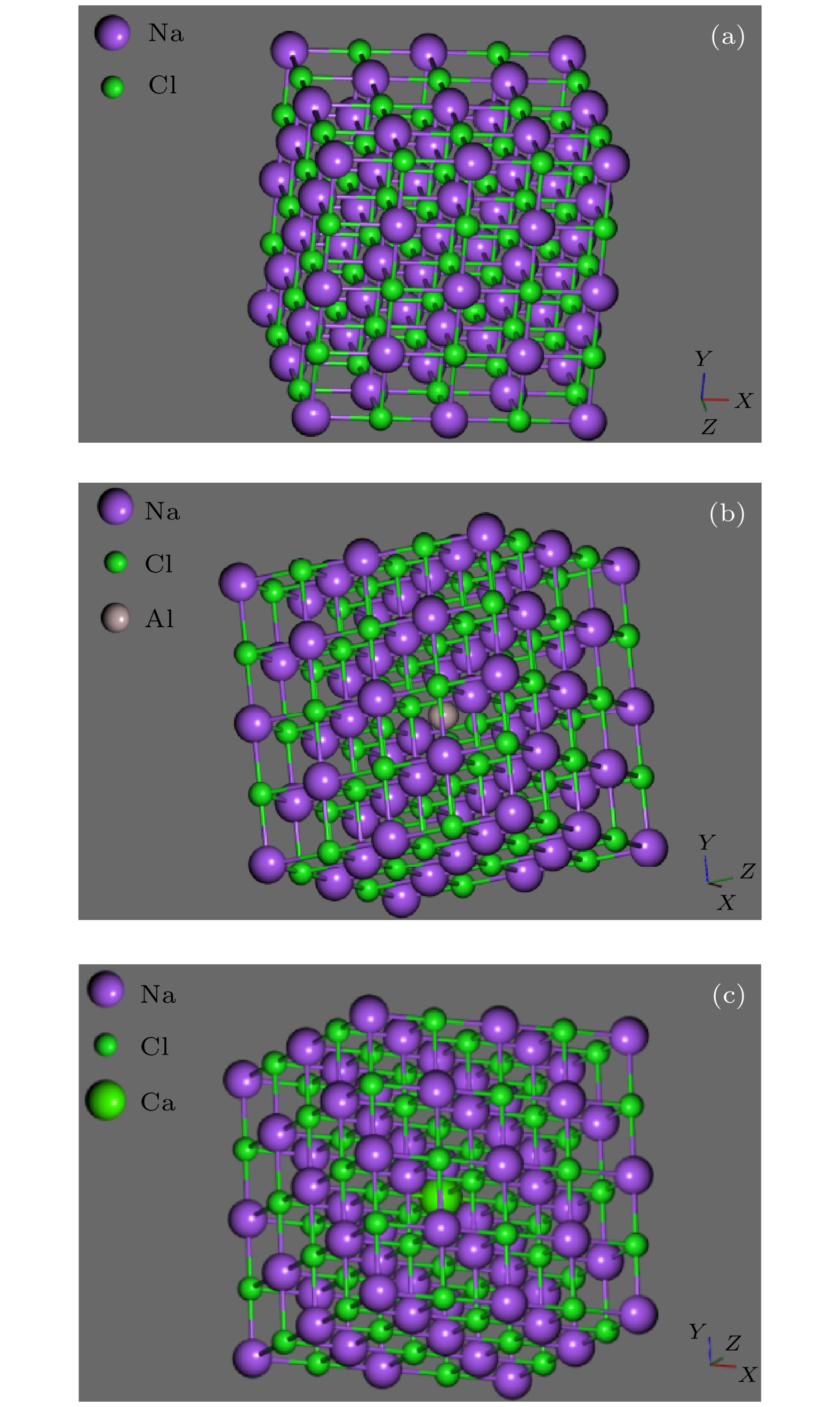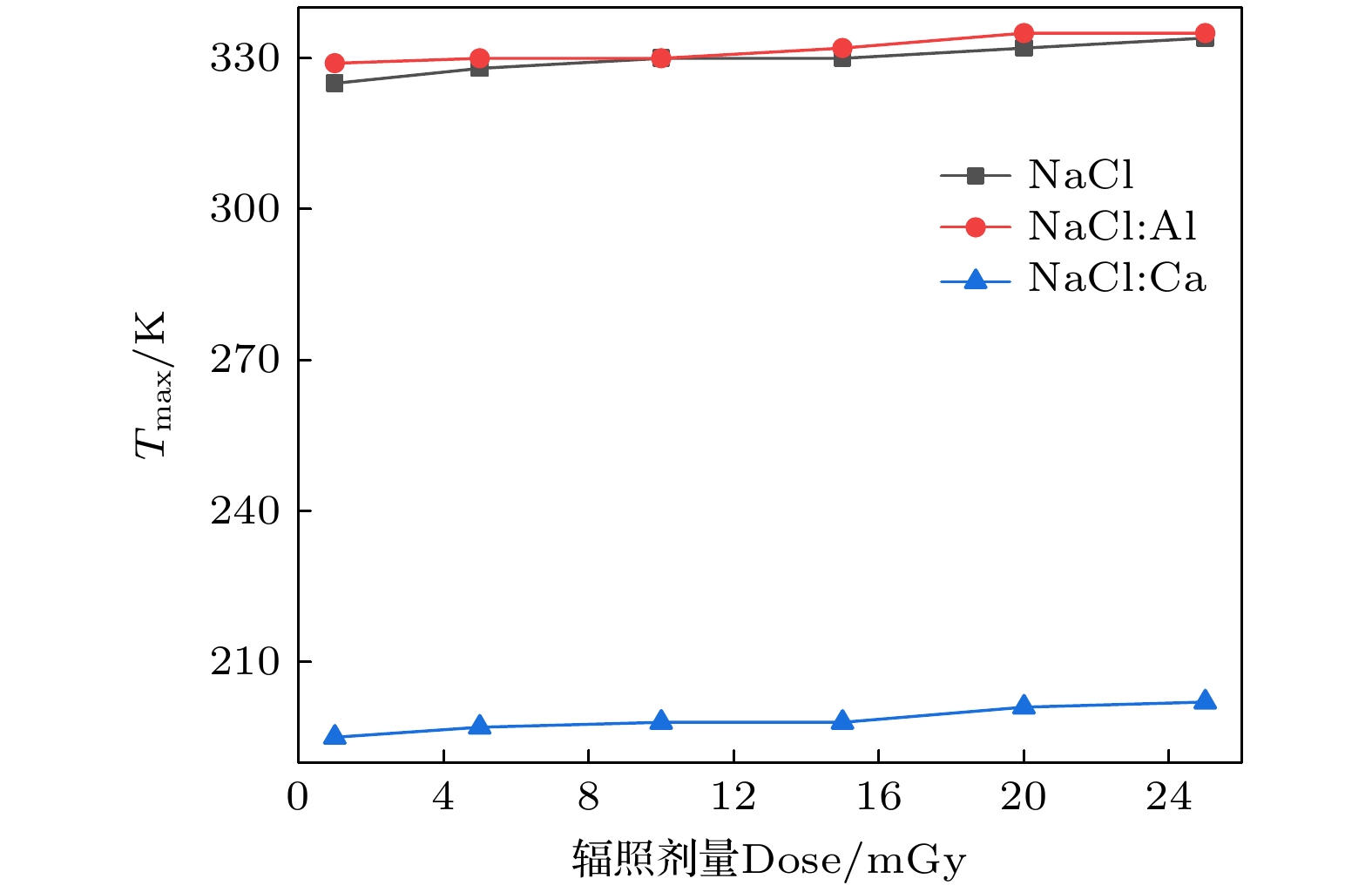-
为深入地了解纯NaCl本身及其Al和Ca掺杂变体的热释光峰值温度偏移特性, 通过第一性原理计算与热释光实验的结合方法, 探讨了掺杂如何影响晶体的电子结构, 并进一步分析热释光峰值温度的偏移机制. 计算结果显示掺杂Al后NaCl的带隙略有增加至5.20 eV, 掺杂Ca则导致带隙显著减小至0 eV, 这些掺杂不仅改变了带隙宽度, 还引入了不同的缺陷形成能, 这可能导致热释光峰值温度在较低温度出现, 且会随实验条件的变化而偏移. 通过热释光实验对理论预测结果进行了验证, 结果显示在加热速率增加时, 所有样品的热释光峰值温度均有所增加, 且NaCl:Al的变化最为显著, 从276 K增至340 K; 而在1—25 mGy剂量范围内随着辐照剂量的增加, 热释光峰值温度的增长变化较小, 尤其是NaCl:Ca仅从195 K增至202 K. 基于第一性原理的计算及热释光峰值温度偏移特性的实验研究对于不同掺杂材料的应用具有重要参考意义.To gain a more in-depth understanding of the thermoluminescence peak temperature shift characteristics of pure NaCl itself and its Al and Ca doped variants, a combination of the first-principles calculations and thermoluminescence experiments is used to explore how doping affects the electronic structure of the crystal and further analyze the mechanism of peak temperature shift in thermoluminescence. The calculations indicate that doping NaCl with Al slightly increases its band gap to 5.20 eV, whereas doping with Ca reduces it dramatically to 0 eV. These changes can modify the band gap width but introduce distinct defect formation energy values. Such changes may cause the thermoluminescence peak temperature to occur at lower temperatures and shift with the change of experimental conditions. The theoretical predictions are validated through thermoluminescence experiments, showing that the thermoluminescence peak temperatures of all samples rise with heating rate increasing. Notably, the change is most significant for NaCl:Al, where the peak temperature rises from 276 to 340 K. Meanwhile, as the irradiation dose increases in a range of 1–25 mGy, the growth of the thermoluminescence peak temperature turns relatively small, especially for NaCl:Ca, the peak temperature rises only from 195 to 202 K. This comprehensive analysis of the electronic structures and defect formation energy provides an insight into the thermoluminescence behavior of NaCl crystal. Doping with Al and Ca introduces mid-gap states that act as traps for charge carriers. These traps play a crucial role in the thermoluminescence process, capturing electrons during irradiation and releasing them upon heating, which leads to the observed luminescence. The presence of these traps and their specific energy levels relative to the conduction and valence bands directly influences the temperature at which the peak luminescence occurs. In addition, this study explores how the changes of electronic structure, caused by doping, affects the recombination process of charge carriers, which is very important for the thermoluminescence phenomenon. It also investigates the influence of external factors, such as the rate of heating and the dose of irradiation, on the stability and shift of thermoluminescence peak temperature. These findings emphasize the complex interactions between material composition, structural defects, and experimental conditions in determining the thermoluminescence characteristics of doped NaCl crystals. The results of this research are of great significance for the application of doped materials in various fields, including radiation dosimetry and solid-state lighting. The ability to manipulate the thermoluminescence peak temperatures through doping opens up new ways for designing materials with tailored luminescence properties for specific applications. This study not only deepens our understanding of the fundamental mechanisms of thermoluminescence but also highlights the potential of first-principles calculations combined with experimental analysis in the development of new materials with desired optical and electronic characteristics.
-
Keywords:
- thermoluminescence properties /
- NaCl doping /
- first-principles /
- electronic structure
[1] 吴丽, 王倩, 李国栋, 窦巧娅, 吉旭 2016 65 037802
 Google Scholar
Google Scholar
Wu L, Wang Q, Li G D, Dou Q Y, Ji X 2016 Acta Phys. Sin. 65 037802
 Google Scholar
Google Scholar
[2] 张欣熠, 王猛, 谷懿, 王勇, 葛良全, 张庆贤, 李潇潇 2023 原子能科学技术 58 471
 Google Scholar
Google Scholar
Zhang X Y, Wang M, Gu Y, Wang Y, Ge L Q, Zhang Q X, Li X X 2023 At. Energy Sci. Technol. 58 471
 Google Scholar
Google Scholar
[3] Rahimzadeh N, Zhang J, Tsukamoto S, Long H 2023 Radiat. Meas. 161 106899
 Google Scholar
Google Scholar
[4] Rezazadeh F, Negarestani A, Sina S, Farajzadeh E, Karari B 2023 Radiat. Prot. Dosim. 199 116
 Google Scholar
Google Scholar
[5] Sekar N 2022 Opt. Mater. 134 113073
 Google Scholar
Google Scholar
[6] Toktamış H, Hatib M, Kılıç H İ, Çanakçı H 2022 Appl. Radiat. Isot. 190 110462
 Google Scholar
Google Scholar
[7] Furetta C, Kitis G 2004 J. Mater. Sci. 39 2277
 Google Scholar
Google Scholar
[8] Bos A J J 2017 Materials 10 1357
 Google Scholar
Google Scholar
[9] Brovetto P, Delunas A, Maxia V, Salis M, Spano G 1991 Nuovo Cimento Soc. Ital. Fis. , D 13 1293
 Google Scholar
Google Scholar
[10] 李永涛, 孟凡萍, 徐硕, 刘卉昇, 张学建, 刘景和, 李春, 曾繁明 2021 硅酸盐学报 49 743
 Google Scholar
Google Scholar
Li Y T, Meng F P, Xu S, Liu H S, Zhang X J, Liu J H, Li C, Zeng F M 2021 J. Chin. Ceram. Soc. 49 743
 Google Scholar
Google Scholar
[11] Hernandez-Medina A, Negron-Mendoza A, Ramos-Bernal S, Colin-Garcia M 2013 Radiat. Meas. 56 369
 Google Scholar
Google Scholar
[12] Bernal R, Cruz-Vázquez C, Brown F, Tostado-García W, Pérez-Salas R, Castaño V M 2014 Electron. Mater. Lett. 10 863
 Google Scholar
Google Scholar
[13] 李哲旭, 李新换, 贺三军, 周芷千, 刘丽艳, 于万瑭, 赵修良 2022 71 137801
 Google Scholar
Google Scholar
Li Z X, Li X H, He S J, Zhou Z Q, Liu L Y, Yu W T, Zhao X L 2022 Acta Phys. Sin. 71 137801
 Google Scholar
Google Scholar
[14] 谢东, 冷永祥, 黄楠 2013 62 198103
 Google Scholar
Google Scholar
Xie D, Leng Y X, Huang N 2013 Acta Phys. Sin. 62 198103
 Google Scholar
Google Scholar
[15] Ye L, Liang Y 2024 Phys. B: Condens. Matter 674 415579
 Google Scholar
Google Scholar
[16] 马天慧, 雷作涛, 张晓萌, 付秋月, 布和巴特尔, 朱崇强, 杨春晖 2022 71 227101
 Google Scholar
Google Scholar
Ma T H, Lei Z T, Zhang X M, Fu Q Y, Bu H B T E, Zhu C Q, Yang C H 2022 Acta Phys. Sin. 71 227101
 Google Scholar
Google Scholar
[17] Gillani S S A, Ashraf U, Zeba I, Shakil M, Rafique M, Ahmad R, Maqsood A 2021 Eur. Phys. J. Plus 136 1065
 Google Scholar
Google Scholar
[18] Bekker T B, Yelisseyev A P, Solntsev V P, Davydov A V, Inerbaev T M, Rashchenko S V, Kostyukov A I 2021 Cryst. Eng. Comm 23 6599
 Google Scholar
Google Scholar
[19] Cruz-Zaragoza E, Ortiz A, Furetta C, Flores J C, Hernández A J, Murrieta S H 2011 Appl. Radiat. Isot. 69 334
 Google Scholar
Google Scholar
[20] Bailey R M 2001 Radiat. Meas. 33 17
 Google Scholar
Google Scholar
-
表 1 Al和Ca掺杂引入的缺陷类型及形成能
Table 1. Types of defects and their formation energies introduced by Al and Ca doping.
缺陷类型 形成能/eV VNa 2.81 AlNa –78.25 Ali –104.34 CaNa –60.55 Cai –85.45 -
[1] 吴丽, 王倩, 李国栋, 窦巧娅, 吉旭 2016 65 037802
 Google Scholar
Google Scholar
Wu L, Wang Q, Li G D, Dou Q Y, Ji X 2016 Acta Phys. Sin. 65 037802
 Google Scholar
Google Scholar
[2] 张欣熠, 王猛, 谷懿, 王勇, 葛良全, 张庆贤, 李潇潇 2023 原子能科学技术 58 471
 Google Scholar
Google Scholar
Zhang X Y, Wang M, Gu Y, Wang Y, Ge L Q, Zhang Q X, Li X X 2023 At. Energy Sci. Technol. 58 471
 Google Scholar
Google Scholar
[3] Rahimzadeh N, Zhang J, Tsukamoto S, Long H 2023 Radiat. Meas. 161 106899
 Google Scholar
Google Scholar
[4] Rezazadeh F, Negarestani A, Sina S, Farajzadeh E, Karari B 2023 Radiat. Prot. Dosim. 199 116
 Google Scholar
Google Scholar
[5] Sekar N 2022 Opt. Mater. 134 113073
 Google Scholar
Google Scholar
[6] Toktamış H, Hatib M, Kılıç H İ, Çanakçı H 2022 Appl. Radiat. Isot. 190 110462
 Google Scholar
Google Scholar
[7] Furetta C, Kitis G 2004 J. Mater. Sci. 39 2277
 Google Scholar
Google Scholar
[8] Bos A J J 2017 Materials 10 1357
 Google Scholar
Google Scholar
[9] Brovetto P, Delunas A, Maxia V, Salis M, Spano G 1991 Nuovo Cimento Soc. Ital. Fis. , D 13 1293
 Google Scholar
Google Scholar
[10] 李永涛, 孟凡萍, 徐硕, 刘卉昇, 张学建, 刘景和, 李春, 曾繁明 2021 硅酸盐学报 49 743
 Google Scholar
Google Scholar
Li Y T, Meng F P, Xu S, Liu H S, Zhang X J, Liu J H, Li C, Zeng F M 2021 J. Chin. Ceram. Soc. 49 743
 Google Scholar
Google Scholar
[11] Hernandez-Medina A, Negron-Mendoza A, Ramos-Bernal S, Colin-Garcia M 2013 Radiat. Meas. 56 369
 Google Scholar
Google Scholar
[12] Bernal R, Cruz-Vázquez C, Brown F, Tostado-García W, Pérez-Salas R, Castaño V M 2014 Electron. Mater. Lett. 10 863
 Google Scholar
Google Scholar
[13] 李哲旭, 李新换, 贺三军, 周芷千, 刘丽艳, 于万瑭, 赵修良 2022 71 137801
 Google Scholar
Google Scholar
Li Z X, Li X H, He S J, Zhou Z Q, Liu L Y, Yu W T, Zhao X L 2022 Acta Phys. Sin. 71 137801
 Google Scholar
Google Scholar
[14] 谢东, 冷永祥, 黄楠 2013 62 198103
 Google Scholar
Google Scholar
Xie D, Leng Y X, Huang N 2013 Acta Phys. Sin. 62 198103
 Google Scholar
Google Scholar
[15] Ye L, Liang Y 2024 Phys. B: Condens. Matter 674 415579
 Google Scholar
Google Scholar
[16] 马天慧, 雷作涛, 张晓萌, 付秋月, 布和巴特尔, 朱崇强, 杨春晖 2022 71 227101
 Google Scholar
Google Scholar
Ma T H, Lei Z T, Zhang X M, Fu Q Y, Bu H B T E, Zhu C Q, Yang C H 2022 Acta Phys. Sin. 71 227101
 Google Scholar
Google Scholar
[17] Gillani S S A, Ashraf U, Zeba I, Shakil M, Rafique M, Ahmad R, Maqsood A 2021 Eur. Phys. J. Plus 136 1065
 Google Scholar
Google Scholar
[18] Bekker T B, Yelisseyev A P, Solntsev V P, Davydov A V, Inerbaev T M, Rashchenko S V, Kostyukov A I 2021 Cryst. Eng. Comm 23 6599
 Google Scholar
Google Scholar
[19] Cruz-Zaragoza E, Ortiz A, Furetta C, Flores J C, Hernández A J, Murrieta S H 2011 Appl. Radiat. Isot. 69 334
 Google Scholar
Google Scholar
[20] Bailey R M 2001 Radiat. Meas. 33 17
 Google Scholar
Google Scholar
计量
- 文章访问数: 2537
- PDF下载量: 66
- 被引次数: 0














 下载:
下载:



